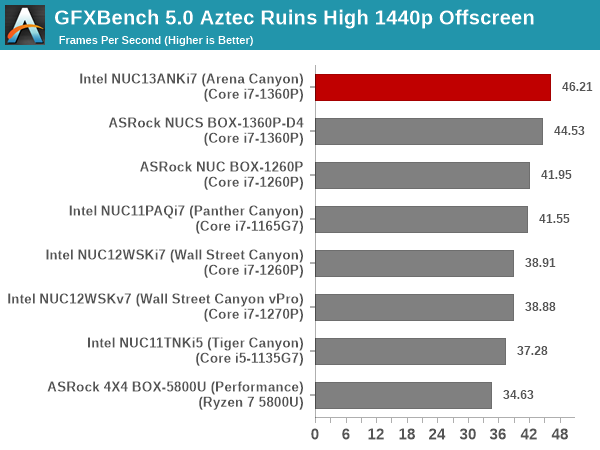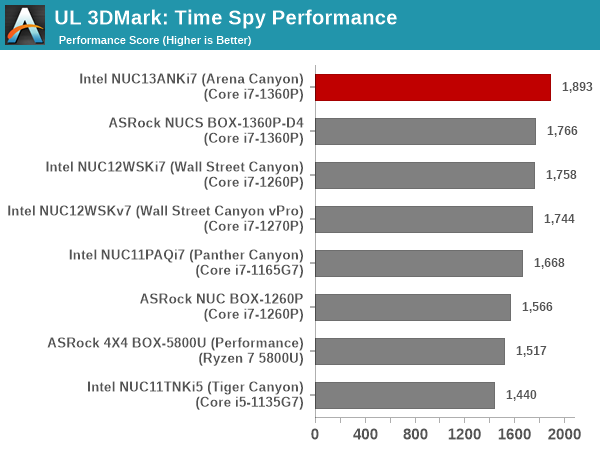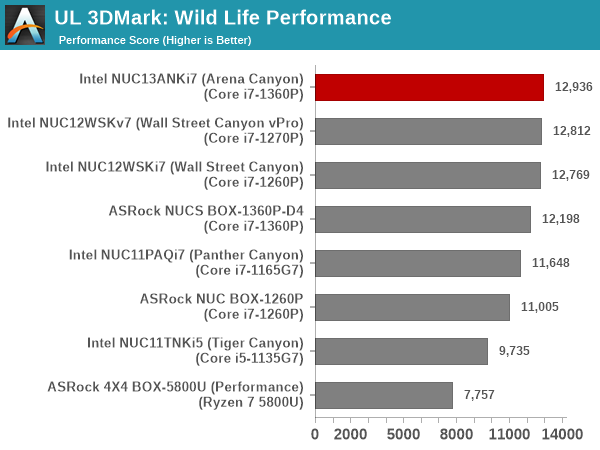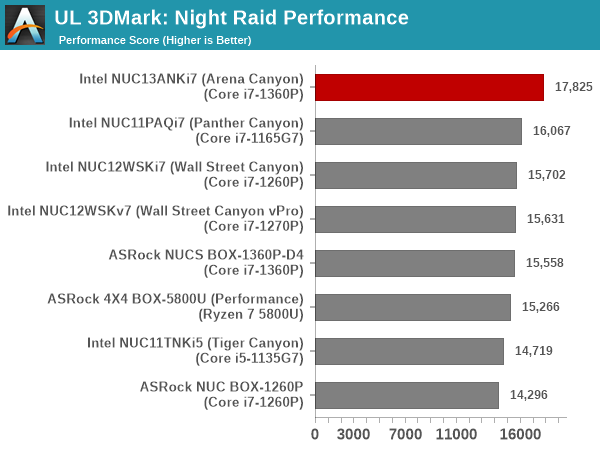Intel NUC 13 Pro Arena Canyon Review: Raptor Lake Brings Incremental Gains
by Ganesh T S on March 27, 2023 9:00 AM ESTGPU Performance: Synthetic Benchmarks
Intel did not make significant changes in the integrated GPU when moving from Alder Lake to Raptor Lake. Process maturity has allowed it to clock the iGPU a bit higher, but the number of EUs remains the same as in the previous generation. GPU performance evaluation typically involved gaming workloads, and for select PCs, GPU compute. Prior to that, we wanted to take a look at the capabilities of the iGPU in the Core i7-1360P. Unfortunately, GPU-Z doesn't yet recognize the 'new' GPU, but HWiNFO has more helpful information tallying with the claimed iGPU specifications.
We have seen earlier that the performance of the Intel Iris Xe Graphics is miles ahead of previous iGPUs from both Intel and AMD. The benchmarks processed on the NUC13ANKi7 back up that aspect.
GFXBench
The DirectX 12-based GFXBench tests from Kishonti are cross-platform, and available all the way down to smartphones. As such, they are not very taxing for discrete GPUs and modern integrated GPUs. We processed the offscreen versions of the 'Aztec Ruins' benchmark.


The 1.5 GHz clock and high EU count expectedly land the Arena Canyon NUC at the top of the file.
UL 3DMark
Four different workload sets were processed in 3DMark - Fire Strike, Time Spy, Night Raid, and Wild Life.
3DMark Fire Strike
The Fire Strike benchmark has three workloads. The base version is meant for high-performance gaming PCs. It uses DirectX 11 (feature level 11) to render frames at 1920 x 1080. The Extreme version targets 1440p gaming requirements, while the Ultra version targets 4K gaming system, and renders at 3840 x 2160. The graph below presents the overall score for the Fire Strike Extreme and Fire Strike Ultra benchmark across all the systems that are being compared.
| UL 3DMark - Fire Strike Workloads | |||

3DMark Time Spy
The Time Spy workload has two levels with different complexities. Both use DirectX 12 (feature level 11). However, the plain version targets high-performance gaming PCs with a 2560 x 1440 render resolution, while the Extreme version renders at 3840 x 2160 resolution. The graphs below present both numbers for all the systems that are being compared in this review.
| UL 3DMark - Time Spy Workloads | |||

3DMark Wild Life
The Wild Life workload was initially introduced as a cross-platform GPU benchmark in 2020. It renders at a 2560 x 1440 resolution using Vulkan 1.1 APIs on Windows. It is a relatively short-running test, reflective of mobile GPU usage. In mid-2021, UL released the Wild Life Extreme workload that was a more demanding version that renders at 3840 x 2160 and runs for a much longer duration reflective of typical desktop gaming usage.
| UL 3DMark - Wild Life Workloads | |||

3DMark Night Raid
The Night Raid workload is a DirectX 12 benchmark test. It is less demanding than Time Spy, and is optimized for integrated graphics. The graph below presents the overall score in this workload for different system configurations.

All of the above benchmarks see the NUC13ANKi7 emerge comfortably on top. Having the fastest iGPU clock and highest power budget mean that this is not a surprising result.











46 Comments
View All Comments
MrCommunistGen - Tuesday, March 28, 2023 - link
If you're just looking to dabble, you might check out Apple's Refurbished shop. I swear by their shop and use it to help my parents getting inexpensive iDevices as they don't need the latest and greatest.They tend to sell pretty lightly used machines that are only a generation or two old at decently discounted prices. If you buy a laptop or other mobile device, I believe that all 1st party Apple Refurbished devices get a brand new battery as part of the refurb process.
FWIW, it looks like through the refurb site you can get an M1 Mac Mini with 16GB RAM and 512GB SSD for $809. Yes, you lose out on the improvements that the M2 brings, but it saves you almost $200 too.
The M1 is going to be plenty potent compared to your... Core2 Duo(?) based Macbook?
Glaurung - Tuesday, March 28, 2023 - link
If you can't stomach apple's prices, check out refurbished/lightly used apple gear on backmarket or, for older machines you can upgrade yourself, Ebay. Apple's official refurb store is great but you will never get more than about 15% off there. I love my apple gear, but I only ever buy used/refurb, because I cannot afford the price Apple charges for new.Affectionate-Bed-980 - Tuesday, March 28, 2023 - link
For how "dead" Anandtech has been in terms of publishing GPU and CPU reviews, I'm surprised we get a NUC update and full review before this is even available for consumers!abufrejoval - Tuesday, March 28, 2023 - link
My NUC10 seems to just have burned through its Thunderbolt port: for some weeks it's lost the connection to the Sabrent/Aquantia 10Gbit NIC after a couple of days, but power cycling brought it back. Now it's just gone completely, just can't seen anything connected on TB any more.So while I needed a replacement, NUC12 is still rather expensive and I am still yearning for something Mini-ITX not NUC anyway, I hit across this one: https://elchapuzasinformatico.com/2023/03/cpu-inte... which is much cheaper than a comparable NUC of that generation.
So I just decided to order one to see if it holds water. I won't be able to reuse the RAM, but with 64GB at €120 that's no longer a pain point and it is a bit more flexible and expandable than the NUCs, while unfortunately it lacks the TB port, but will allow me to use one of my AQC107 PCIe x4 NIC in storage.
Mini-ITX with one of my Noctuas allows to raise the sustained TDP to 35 Watts without getting annoying, while idle power consumption might not be very different. That's my main beef with desktop based Mini-ITX hardware, I want the lowest idle power and then "comfortable" peak performance without getting distracted by noise, heat or electric bills.
H- and P-class SoCs from AMD and Intel basically allow that, but are hard-to-get in these smaller form factors: high-end notebooks obviously represent the more attractive sales channels and older parts are leak into these Chinese surplus channels only when laptops have switched to the next generation.
abufrejoval - Tuesday, March 28, 2023 - link
IMHO one of the biggest missing elements for several generations now has been lack of ECC support. With both "normal" and inline ECC most likely being included in the silicon, it's really just market segmentation again and a reason to go with Ryzen, if ECC support on their APUs wasn't such a lottery game, too.64GB is half a billion bits where things can go wrong and I just like the odds less and less...
Up2Trix - Wednesday, April 19, 2023 - link
@abufrejoval: I agree 100%. ECC DRAM is the single most important hardware feature that most people need but don't have a clue about. I curse Intel for segmenting it out of existence, and AMD for not promoting it. May the world wake up...Anyone know of a small form factor / NUC like computer with ECC support? Intel's NUC 9 Pro / Quartz Canyon from 2019 is the only one that I can readily find.
Fenturi - Tuesday, March 28, 2023 - link
I'm not sure the price/performance is here for this one vs chips like 6800HX with a much better igpu. That said two thunderbolt ports are very interesting for my use case and would be the best feature.abufrejoval - Tuesday, March 28, 2023 - link
I see the 96EU Xe doing 5-25% better than the 5800U iGPU and iGPUs typically get Wattage priority over CPUs so a "H" class iGPUs don't do better than "U", no matter if I operate the SoC at 15-28 (AMD) or 15-64 Watt (Tiger Lake NUC).So the 6800 generational uplift may just put AMD ever so slightly in the lead again, but in a race of sloths vs turtles.
For TB I keep hearing that many of the USB4 ports on AMD APUs are actually TB capable and only lack certifications... Have not had a chance to verify that.
I can't mix AMD and Intel in my clusters, so it's too late for me to switch. But the other thing is that I needed 10Gbit and for that TB sadly was a must, because for some crazy reason vendors believe 1/2.5Gbit is adequate for NVMe systems.
I've wanted mobile SoC based mainboards with PC type flexibilty for years, but only some crazy Chinese companies are selling that.
Fenturi - Tuesday, March 28, 2023 - link
Sadly, as someone who has built my own systems going back to 486 CPUs and outrageous fast wide SCSI and a super expensive video card.I think the days of building desktop PC is in it's last days.
Most people are going to only need small nuk sized units that will do most of what they need.
abufrejoval - Tuesday, March 28, 2023 - link
I can beat that, started with an 80286 (actually with an Apple ][ clone before that) and SCSI fast, wide or dual channel came much later, it was MFM and RLL before, using PIO, because the 8-bit DMA from the original PC simply wasn't fast enough for anything beyond floppy. BTW that system cost me more than a new middle class car would have and the people and shops selling them, would reflect that (suits, ties and talk): Those weren't just another microwave like box at the mall.Yes, after more than 4 decades the PC era is drawing to a close, but I'm not sure it's from lack of scale at the desktop: it's ARM from above and below that will spell the end of the x86 evolution.
There are way more PC enthusiasts today than there were PC users when we got hooked and custom builds just never scale: IKEA!
To me the real successor of the PC is the smartphone, but only if it isn't actually an Apple or Google remote control.